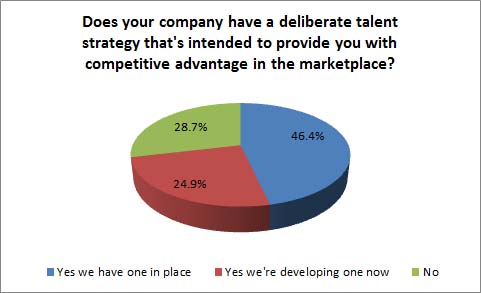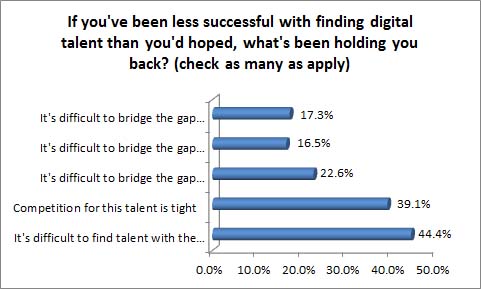Drive your strategic HR advantage by attending the CEO Talent Summit
October 13th and 14th, 2016, Cincinnati, Ohio
This year’s CEO Talent Summit gives you direct access to peers dealing with and solving the same talent challenges you face. Learn how they implement everything from groundbreaking recruiting and retention strategies to world-class training programs and new technology to adapt to a changing workforce. Find out more at www.ceotalentsummit.com.
In a recent survey conducted by Chief Executive magazine, nearly three-quarters of responding CEOs indicated they either had a deliberate talent strategy in place already or were currently developing one (46% have one; 25% are developing one). And these respondents indicated they were actively involved in both the development and execution of those strategies (72% were either extremely or actively involved).


For most companies, a key part of that talent strategy is the effort to attract and retain digital-savvy talent. But, while 40% of Chief Executive’s survey respondents indicated they were successful in this effort, more than half said they weren’t attracting as much talent as they need, and 9% said they had not been able to attract and retain this type of talent at all.
Behind their lack of success were two key factors: difficulty finding talent with the right skills (44%) and tight competition for the talent they’ve identified (39%). In addition, nearly a quarter of respondents said they found it difficult to bridge the gap between legacy and digital talent; smaller percentages cited issues bridging gaps between generations (17%) as well as gaps between technical and business teams (17%).

One approach some companies have adopted to appeal specifically to Millennial talent is what’s known as the Results-Only Work Environment (ROWE). Survey respondents were asked if they’d considered this approach. While 30% said they had (and 47% said they had not), a quarter of respondents said they weren’t familiar with ROWE. For those who had not implemented ROWE, 43% said they were concerned that the system made it difficult to manage a consistent corporate culture, and 41% felt that they would have difficulty measuring results. Nearly a third, while potentially interested in the program, doubted whether it could be scaled to work for a company their size. Only a quarter of respondents worried whether ROWE employees would get their work done. One of those respondents noted that “there are many non-tangible activities that are hard to measure, but if they don’t get done, there would significant negative impacts.”
To learn more about ROWE, see “The Results-Only Work Environment: How It Benefits More Than Just Millennials,” on ChiefExecutive.net, and listen to Greg Watt, CEO of WATT Global Media, tell the story of his company’s successful ROWE implementation at the CEO Talent Summit, October 13-14, in Cincinnati. Also at the Talent Summit, David Taylor, CEO of Procter & Gamble will take a look at how to create and sustain competitive advantage through talent, and former P&G CEO A.G. Lafley will describe “The CEO’s Role in Creating a Winning Talent Strategy.” For more information about the CEO Talent Summit, and to register, visit www.ceotalentsummit.com.
You might also like:
The Results-Only Work Environment: How it Benefits More Than Just Millennials
Reinventing Yourself: How to Stay Relevant—and Keep Your Job
Are You a Superboss? Here’s How to Tell
How One State Works to Match Talent with Industry Need
5 Steps to Help You Trim Your Turnover
Is Your Contractor Really an Employee?
Chief Executive Group exists to improve the performance of U.S. CEOs, senior executives and public-company directors, helping you grow your companies, build your communities and strengthen society. Learn more at chiefexecutivegroup.com.
0

1:00 - 5:00 pm
Over 70% of Executives Surveyed Agree: Many Strategic Planning Efforts Lack Systematic Approach Tips for Enhancing Your Strategic Planning Process
Executives expressed frustration with their current strategic planning process. Issues include:
Steve Rutan and Denise Harrison have put together an afternoon workshop that will provide the tools you need to address these concerns. They have worked with hundreds of executives to develop a systematic approach that will enable your team to make better decisions during strategic planning. Steve and Denise will walk you through exercises for prioritizing your lists and steps that will reset and reinvigorate your process. This will be a hands-on workshop that will enable you to think about your business as you use the tools that are being presented. If you are ready for a Strategic Planning tune-up, select this workshop in your registration form. The additional fee of $695 will be added to your total.

2:00 - 5:00 pm
Female leaders face the same issues all leaders do, but they often face additional challenges too. In this peer session, we will facilitate a discussion of best practices and how to overcome common barriers to help women leaders be more effective within and outside their organizations.
Limited space available.

10:30 - 5:00 pm
General’s Retreat at Hermitage Golf Course
Sponsored by UBS
General’s Retreat, built in 1986 with architect Gary Roger Baird, has been voted the “Best Golf Course in Nashville” and is a “must play” when visiting the Nashville, Tennessee area. With the beautiful setting along the Cumberland River, golfers of all capabilities will thoroughly enjoy the golf, scenery and hospitality.
The golf outing fee includes transportation to and from the hotel, greens/cart fees, use of practice facilities, and boxed lunch. The bus will leave the hotel at 10:30 am for a noon shotgun start and return to the hotel after the cocktail reception following the completion of the round.